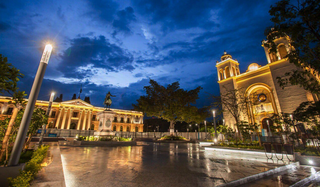
San Salvador is the capital and the largest city of El Salvador and its eponymous department. It is the country's political, cultural, educational and financial center. The Metropolitan Area of San Salvador, which comprises the capital itself and 13 of its municipalities, has a population of 2,404,097. The urban area of San Salvador has a population of 1,600,000 inhabitants.

Coyoacán is a borough in Mexico City. The former village is now the borough's "historic center". The name comes from Nahuatl and most likely means "place of coyotes", when the Aztecs named a pre-Hispanic village on the southern shore of Lake Texcoco dominated by the Tepanec people. Against Aztec domination, these people welcomed Hernán Cortés and the Spanish, who used the area as a headquarters during the Spanish conquest of the Aztec Empire and made it the first capital of New Spain between 1521 and 1523.

Old San Juan is a historic district located at the "northwest triangle" of the islet of San Juan in San Juan. Its area roughly correlates to the Ballajá, Catedral, Marina, Mercado, San Cristóbal, and San Francisco sub-barrios (sub-districts) of barrio San Juan Antiguo in the municipality of San Juan, Puerto Rico. Old San Juan is the oldest settlement within Puerto Rico and the historic colonial district of the city of San Juan. This historic district is a National Historic Landmark District and is listed on the United States National Register of Historic Places as the Old San Juan Historic District. Several historical buildings and structures, particularly La Fortaleza, the city walls, and El Morro and San Cristóbal castles, have been inscribed in the UNESCO World Heritage Site list since 1983. Historically the mixed use commercial and residential real estate in the main streets like Cristo Street, Fortaleza Street (north) from Tanca Street to the Governor’s Mansion is the most valuable in the area and it has kept its value and increased steadily through several years despite the past economic turmoils.

Manuel Lisandro Barillas Bercián was a Guatemalan general and acting president of Guatemala from 6 April 1885 to 15 March 1886 and President from 16 March 1886 to 15 March 1892. He was born in Quetzaltenango, and assassinated in Mexico City in 1907.

Yautepec is a municipality located in the north-central part of the Mexican state of Morelos. The municipal seat is the city of Yautepec de Zaragoza. It stands at 18°53′N99°04′W.

General Carlos Humberto Romero Mena was a Salvadoran army general politician who served as President of El Salvador from 1 July 1977, until his overthrow in a coup d'état on 15 October 1979.

José Gerardo Barrios Espinoza was a Salvadoran military officer and politician who served as president of El Salvador on three occasions between June 1858 and his overthrow in October 1863.

Fernando Figueroa was the President of El Salvador from 14 May to 18 June 1885 and again from 1 March 1907 to 1 March 1911. He also served twice as Minister of National Defense and Governor of San Vicente.

Juayúa is a city and municipality in the Sonsonate department of El Salvador. It is a small town up in the mountains, founded in 1577. Juayua is located in the western part of El Salvador, about 50 miles from San Salvador.
San Antonio del Monte is also a subdivision of Garafía in the island of La Palma in the Canary Islands

The municipalities or municipios of El Salvador correspond to the second level administrative division in the Republic of El Salvador which divide its departments. El Salvador contains 262 municipalities.
Santo Domingo Yanhuitlán is a village and municipality in the state of Oaxaca, Mexico, located northeast of Oaxaca city. It is part of the Nochixtlán District in the southeast of the Mixteca Region. It is 2,140 meters above sea level. Its name comes from the patron saint of the town and the last part is from Náhuatl meaning “near something new”.

Monumento al Divino Salvador del Mundo is a monument located on Plaza El Salvador del Mundo in San Salvador City, El Salvador. It consists of a statue of Jesus Christ standing on top of a global sphere of planet Earth, placed on top of the tall four-sided concrete base pedestal. It is a landmark located in the country's capital San Salvador. It is a symbol that identifies and represents both El Salvador and Salvadorans throughout the world.

The San Salvador historic downtown includes the area where the capital city of El Salvador has been located since the 16th century. This district has long been the country's political, economic and religious center.

Mixcoac is an area of southern Mexico City which used to be a separate town and municipality within the Mexican Federal District until it was made part of Mexico City proper in 1928.
The War of 1863 was a conflict fought between El Salvador and Guatemala from 13 February 1863 to 26 October 1863.

The Captain General Gerardo Barrios Military School, abbreviated as the EMCGGB, was a military academy in El Salvador. It was established in 1868 and is named after Captain General Gerardo Barrios who served as President of El Salvador from 1859 to 1863. It was located in Antiguo Cuscatlán, Santa Tecla, La Libertad. It was demolished in June 2022 to make way for the construction of the Estadio Nacional de El Salvador.

The National Stadium of El Salvador is a 50,000-seat multi-purpose stadium under construction in Antiguo Cuscatlán, El Salvador intended as a replacement for the El Salvador national football team's current stadium, Estadio Cuscatlán. The stadium is being built on the site of the former Captain General Gerardo Barrios Military School. The construction of the US$500 million stadium began on 8 September 2022. It will be the second modern sport and event arena to be built in Central America.

















